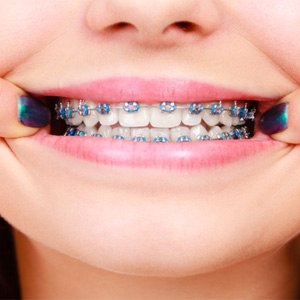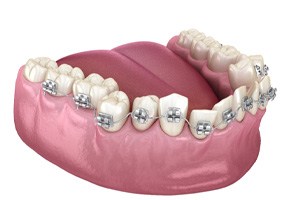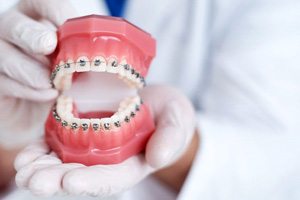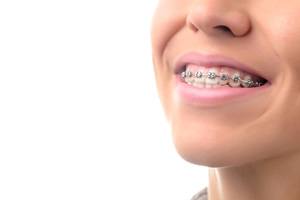
Traditional Braces – Northborough, MA
Reliable and Cost-Effective Orthodontia

Today, a number of innovative orthodontic treatments have captured the attention of patients. However, traditional braces in Northborough remain as relevant and effective as ever. This remarkable teeth-straightening method is suitable for most people, tends to be relatively affordable, and offers numerous other benefits. Read on below to learn more about braces and how they may be able to enhance both your oral health and your smile’s aesthetics. Then, when you are ready for an orthodontic consultation, get in touch with our team .
Why Choose Northborough Dental Associates for Traditional Braces?
- Highly Skilled Team
- Suitable for Almost All Orthodontic Cases
- Flexible Payment Options
How Do Traditional Braces Work?

Traditional braces use brackets, which your dentist in Northborough bonds onto your teeth. A wire connects the brackets. Together, the brackets and wire apply enough pressure to the teeth to move them gradually over time. Braces are adjusted at periodic appointments in order to ensure the teeth stay on track while on their way to their ideal positions. The total treatment time for braces varies from person to person, but most cases take 18 – 36 months to complete.
What Orthodontic Issues Can Braces Fix?

During your consultation, we will let you know whether we believe braces are a fit for your circumstances. They are able to correct almost all orthodontic issues, from the mild to the severe. Here are a few examples of problems that they are commonly used to address:
Bite Misalignment
Overbite, underbite, cross bite, and open bite are all forms of malocclusion (bad bite). Such issues can cause difficulty eating, affect facial aesthetics, and even contribute to TMJ disorder. Braces are usually capable of addressing bite issues, usually along with the help of accessories that train the lower jaw to rest in its proper position.
Crowded & Crooked Teeth
Crooked and crowded teeth can easily trap food between them, increasing the risk of issues like decay, gum disease, and bad breath. Braces can ease this problem by moving the teeth apart, providing each one with the space it needs to function properly and be easily cleaned. In some cases, extractions prior to orthodontic care make it possible to address overcrowding in the mouth.
Gapped Teeth
Abnormally large gaps between the teeth can look unsightly, particularly if the empty space is near the front of the mouth. They also leave the gums vulnerable to irritation and damage. Often, braces can lessen or eliminate this problem by shifting the teeth so they are closer together. Treatment typically results in improved aesthetics and other noteworthy benefits.
Caring for Your Braces

To properly care for your braces, you should:
- Follow all hygiene instructions provided by your dentist or orthodontist. You may have to use special instruments to clean your teeth and brush more often than you are used to.
- Adjust your diet. Foods that could damage your braces’ wire or dislodge your brackets should be avoided. This includes sticky and hard items.
- Attend all appointments. Not only should you regularly attend orthodontic appointments, but you should continue to keep up with your twice-yearly preventive checkup and cleaning.
Understanding the Cost of Traditional Braces

The cost of traditional braces differs from patient to patient. When you visit us for your complimentary consultation, we can share some specific numbers with you and help you to understand your payment options. Often, with the help of financing and other provisions, patients do not find it too difficult to afford necessary care.
Factors That Affect the Cost of Traditional Braces

Some factors that can have a bearing on the cost of traditional braces include:
- Severity of the dental misalignment. More complex and severe cases require a longer treatment timeline, more appointments, and possibly specialized accessories. Therefore, they tend to incur higher costs.
- Your age. In some cases, treatment for adults is more challenging than it is for younger patients. Therefore, more mature individuals may have a higher overall financial obligation.
- Compliance with treatment guidelines. You should be diligent to follow all treatment instructions. For example, you should wear rubber bands if necessary. Failure to do so could slow down your treatment and increase the total cost of your braces.
Professional Braces vs. “DIY” Braces: Which Costs More?

Sometimes, social media promotes DIY braces. Influencers might encourage the use of household or over-the-counter objects, such as paperclips, fishing line, and even superglue to make at-home braces. These ideas might seem like an inexpensive and convenient way to straighten teeth, but they could actually end up costing you more in the long run.
Often, people who try DIY braces end up moving their teeth in the wrong direction. Therefore, they worsen their oral health and end up having to pay more to get their smile back on track. In some instances, they have even caused permanent harm to their teeth. It is wiser to invest in professional treatment right from the outset.
Does Dental Insurance Cover Braces?

Here are a couple of notes to keep in mind about dental insurance and braces:
- Plans are more likely to cover braces for minors than for adults. Usually, only high-end insurance policies cover orthodontia for patients over 19 years of age.
- If your plan includes orthodontic coverage, you may have a lifetime maximum for how much the insurance company will pay for braces. Usually, the maximum is around $1000.
- The coverage rate for braces is usually 50%, up to the amount of the policy’s orthodontic maximum.
If your insurance does not cover braces, you might be able to use your flexible spending account or healthcare savings account to reduce your out-of-pocket costs.
Options for Making Braces Affordable

Beyond insurance, there are a few provisions that might make it easier to afford braces:
- We work with CareCredit and Sunbit to provide low-interest payment plans for dental and orthodontic treatment. Applying is easy, and most patients are approved for credit.
- Essential Dental plan. This discount plan, designed for patients without insurance, provides reduced fees for most of the services available in our practice.
Are you ready to learn more about braces and their cost? Contact Northborough Dental Associates today! We are looking forward to speaking with you.
Traditional Braces FAQs

Traditional metal braces are one of the best ways to address a broad range of orthodontic problems. Before you commit to a consultation with our team, however, you may be eager to learn more about the experience that awaits you. To help you gather information, we have put together the following list of FAQs, along with easy-to-understand answers. If your questions are not included here, reach out to us directly. We will be glad to speak with you!
Am I Too Old to Get Braces?
Traditional braces are often thought of as a treatment for children and teenagers. The truth is, though, that there is no upper age limit for braces. Many patients in their 20s, 30s, and older have benefited from them.
The treatment experience for adults is slightly different than it is for younger people. For example, it might take a bit longer for you to see results. It might also cost more because dental insurance is more likely to cover orthodontia for minors than it is for adults. Fortunately, our office offers a number of convenient payment options that may make it easy for you to afford your braces.
What Happens After You Get Your Braces Off?
Teeth have a sort of memory, so after your braces are removed, your smile will be inclined to shift back to the way it was before your orthodontic treatment. To prevent that from happening, we will provide you with a retainer.
At first, you may need to wear your retainer full-time (22 hours a day). After a while, though, you might need to use it only at night.
How Long Do Traditional Braces Take?
The treatment timeline with braces can vary greatly from case to case. On average, braces can take anywhere from 12 months to 36 months.
Some factors that can affect how long your treatment will take include:
- Your age. The teeth of adults tend to move more slowly than those of children.
- The severity of your dental misalignment. Logically, more severe and complex cases take longer to address.
- Your compliance with treatment instructions. If you fail to do as we ask, it could delay your final results and lead to higher overall expenses.
Do Traditional Braces Hurt?
A degree of soreness is to be expected with any type of orthodontic treatment. After all, braces are designed to apply pressure to your teeth! For some people, the metal brackets and wires of their braces can also cause some discomfort.
Here are some tips to make your experience as easy as possible:
- Sip on cold water to sooth sore oral tissues.
- Use over-the-counter pain relievers as necessary.
- Eat soft foods for a few days after every braces adjustment.
- Call us if you experience any severe or prolonged pain.